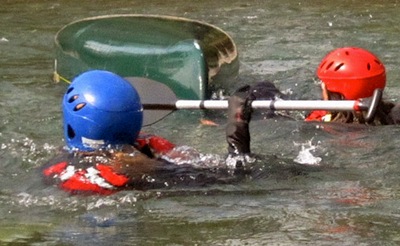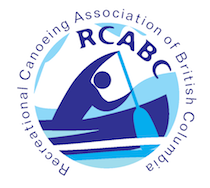
If you're out canoeing regularly, it is likely that sooner or later you'll capsize. If you're not sure how to deal with capsizes, the results can range from fun to unsettling to quite dangerous. With training, practice and experience, performing a rescue can become simple and routine, even when it is unexpected.
RESCUE TOPICS:
If everyone in your group has rescue training, some practice and good judgement, the chances of having a serious incident are quite low. Of course preventing capsizes in the first place is the obvious approach.
There are several ways to perform rescues depending on the situation you are in. No two rescues are ever exactly the same because of how the swimmers respond, the type of canoe, how gear was stored, etc. How to do them and what to do if you're the capsized swimmer can only be learned with training and experience, but we've listed a few things to focus on below. Focus on making rescues simple, manageable and fun and they become something to manage instead of fear.
It takes practice to remember these things when your world suddenly goes upside down and very wet, but when you capsize:
- Hang on to your canoe (It's like a big PFD and you generally want to stay with it)
- Hang on the your paddle (You'll need it later)
- Check on your partner (Make sure they've gotten out of the canoe OK and aren't injured or panicing)
If you're on a river, get to the upstream end of your canoe, initiate a self rescue and listen and watch for assistance from your group. If the current is moving you towards a hazard like a hole or a log jam, abondon the canoe and swim away from the hazard.
The priorities of rescue are:
- You! (Don't get yourself into a dangerous situation that you can't handle.)
- Your group (They need to stay safe and not add to the complexity.)
- The person in the water (They knew the risks when joining the trip, right?)
- Their gear (Gear is lowest priority. Focus entirely on the people.)
Don't create another victim! Make sure you and your group are not in immediate danger. A common mistake is to focus on gear. Gear is replaceable, people aren't.
There are many types of rescues.
- T Rescues or Canoe over Canoe
- Curl rescue
- Swimming to shore rescue
- Capistrano flip
- Self rescue with flotation
- and more....
These rescues have endless variations and choosing the right one for the situation and fine tuning the approach take some practice and experience.
The type of rescue you choose will depend on:
- Where you are (river, lake or ocean)
- Solo or tandem
- Alone with no help (self rescue) or in a group
- How cold the swimmers are and the hypothermia potential
- Distance from shore
- Rescues are too dangerous to perform (waves, wind, river hazards)
- Unloaded (on a day trip with little gear)
- Loaded with gear (tethered)
- Loaded with gear (tied in securely)
- Equipped with a sprayskirt or extra flotation.
There are RCABC courses that can give you experience with all of these situations and methods.
Back to Top...



















